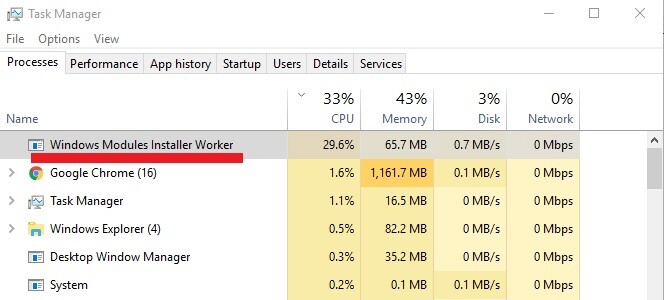Windows Modules Installer Worker is a Windows process that is responsible for the automatic installation of new system updates. Windows Modules Installer Worker is constantly running by default and because of this may sometimes cause a significant increase in the use of RAM and CPU.
Windows users oftentimes complain that the Windows Modules Installer Worker uses up too much of their computer’s resources, causing slow-downs and even occasional freezes. Some even come to the incorrect conclusion that this process is related to some form of malware that is doing something harmful in the system.
Windows Modules Installer Worker
Windows Modules Installer Worker isn’t a harmful process and you shouldn’t be concerned about it – it is perfectly normal for it to use up a lot of your computer’s RAM and CPU while searching for updates and while downloading and installing them. If, however, the slow-downs are becoming way too frequent and if they are preventing you from normally using your computer, there is something you can do to restrict the activities of the Windows Modules Installer Worker process.

The Windows Modules Installer Worker Process
Stopping the automatic updates
The most effective way to reduce the RAM/CPU consumption caused by the Windows Modules Installer Worker process is to block the automatic updates in your computer. Note, however, that once you do that, your system won’t be getting any updates unless you install them manually. This means that if you forget to install new updates, your computer may become vulnerable to newer forms of malware, so only proceed if you are aware of the potential risks and okay with them.
Here’s what you need to do in order to block the automatic Windows updates:
- On your keyboard, press the Winkey + R keys to open Run.
- In the text box, type services.msc and hit Enter.

- In the services window, locate the service named Windows Update and double-click on it.
- In the window that opens, click on the Stop button to stop the service from running.
- Next, set the Startup type to manual and click on OK.

- Restart your computer so that the changes can take place.
The next time you start your PC, Windows Update (the Windows Modules Installer Worker process) wont’ start automatically and your RAM and CPU would no longer be used for the automatic updates. You will immediately notice the difference in RAM/CPU consumption. However, as we pointed out above, this leaves your system exposed to potential attacks from newer forms of malware that exploit outdated weaknesses in your system. That is why we strongly advise you to turn on the Windows update service when the computer is turned on but you aren’t using it. To do that, simply follow the steps we gave you above and once you get to the Windows Update service properties window, click on Start to start the service. This will keep the automatic updates running while you aren’t using the computer. Once you need to use the machine and don’t want the Windows Modules Installer Worker process to be using up RAM and CPU, simply go back to Services and once again Stop Windows Update.

Leave a Comment